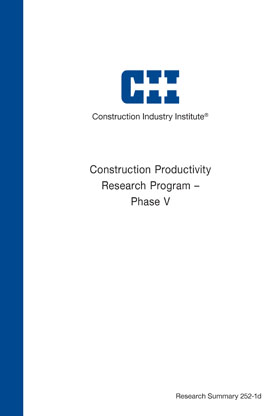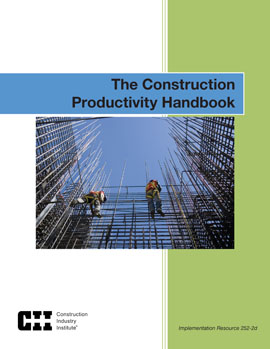
Construction Productivity Research Program -- Phase V
CII initiated the Construction Productivity Program in 2007, when it chartered Research Team (RT) 252. The team's primary objectives were to identify and validate one or more initiatives, techniques, or methods that, if implemented, would result in a breakthrough improvement in construction productivity on CII projects. Construction productivity was defined as having three dimensions: 1) direct work rate, 2) labor productivity, and 3) rework rate. RT 252 conducted its research in five phases over six years, producing over a dozen useful tools published by CII. Research in Phase V focused on completion of three implementation resources: 1) The Construction Productivity Handbook, 2) the Best Productivity Practices Implementation Index (BPPII) for Industrial Projects, and 3) Best Productivity Practices Implementation Index (BPPII) for Infrastructure Projects. This research summary primarily focuses on the key findings and recommendations related to those three implementation resources. It also places those findings in the context of the overall program.
The research team reached a number of conclusions and formulated several lessons learned in the course of the entire research program. In the team's analysis of the hundreds of projects that report their productivity and their levels of practice implementation in the CII Benchmarking & Metrics (BM&M) database, a number of CII Best Practices emerged, as being related to differences of up to 50 percent in productivity (i.e., labor hours per unit output) between groups of low and high implementers. These best productivity practices were safety, materials management, systems integration and automation, team building, front end planning, and constructability.
In the course of the entire research program, the team also investigated a number of processes, materials, and technical innovations by collecting data through numerous jobsite visits and studies. Several innovations were found to have impacts on labor productivity of up to 50 percent, with equal or better overall cost impacts than conventional alternatives. These innovations include the following: quick-connect systems for piping, formwork, and structural steel; self-consolidating concrete; and advanced scaffolding and formwork systems.
In its examination of direct work, the team found that wrench time could be increased on average by about 15 percent with the use of activity analysis processes and tools described in Implementation Resource (IR) 252-2a, Guide to Activity Analysis, and IR 252-4d, The Construction Productivity Handbook. Moreover, the team concluded that rework could be reduced by similar amounts through processes described in IR 252-2b, A Guide to Construction Rework Reduction. This conclusion was validated with over 26 project data points. The team expects that use of the Workforce Development Assessment—a resource investigated during the fourth phase of the program and discussed in Research Summary (RS) 252-1c, Construction Productivity Research Program – Phase IV—will drive similar results.
While these are useful conclusions, the team found that CII had not studied many commonly accepted practices for improving construction productivity, and that practitioners were looking for a comprehensive synthesis of CII practices and commonly accepted practices, in the form of a single tool. The tool would have to be complementary to known CII Best Practices tools and be simple to use. Thus, the team developed the BPPII–Industrial and the BPPII–Infrastructure and then used data from almost 60 projects to validate it. While the work on the BPPII tools and on The Construction Productivity Handbook was conducted across all five program phases, the majority of the validation and analysis, as well as the actual composition, took place in Phase V. The validation analysis prompted the following conclusions:
- The group of projects studied that had high BPPII–Industrial scores had, on average, 28 percent better productivity than did the low-scoring group.
- The group of projects studied that had high BPPII–Infrastructure scores had, on average, 34 percent better productivity than the low-scoring group.
Due to limited time and resources, the team was unable to produce BPPII tools for the building, residential, and small projects sectors. Furthermore, the team only evaluated a targeted group of the innovations in processes, materials, and tools that are currently readily available or are now emerging in the market. Thus, more research on means and methods for improving construction productivity would be worthwhile.



